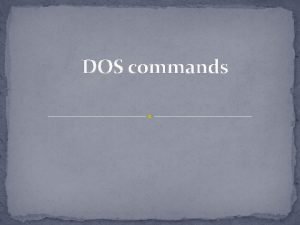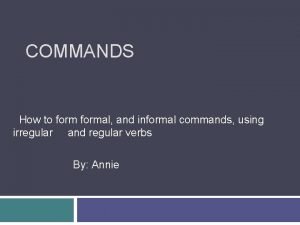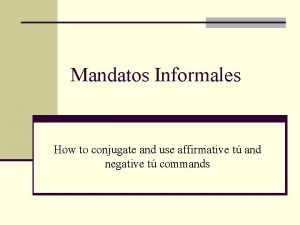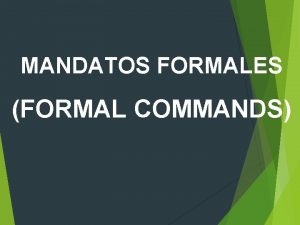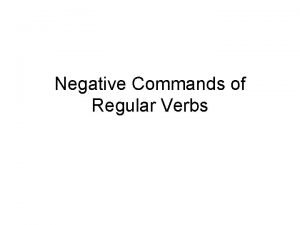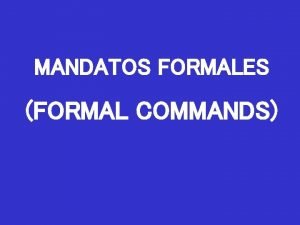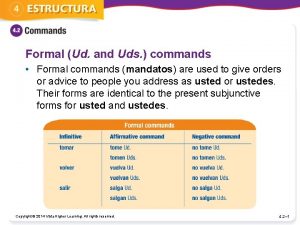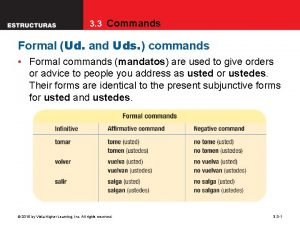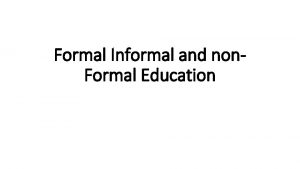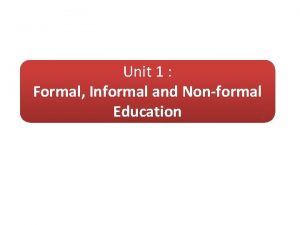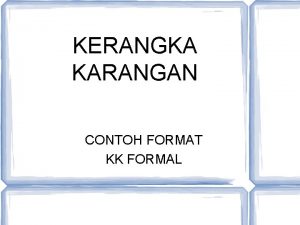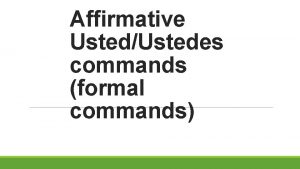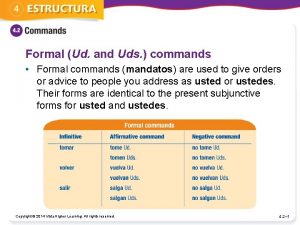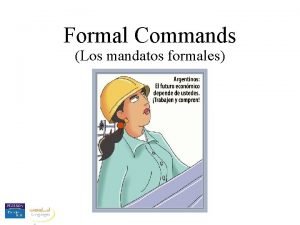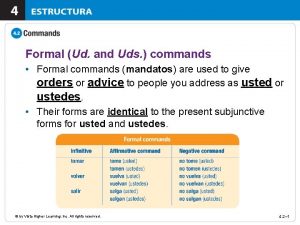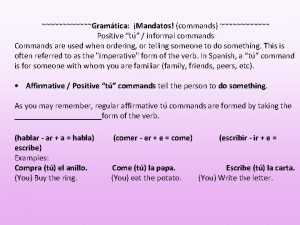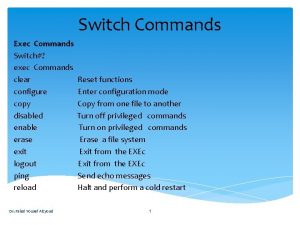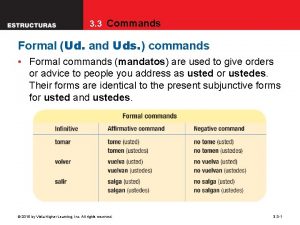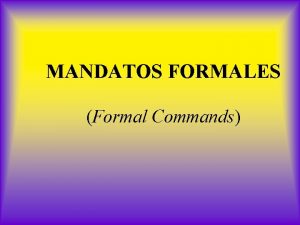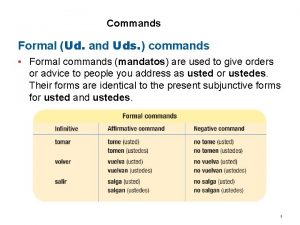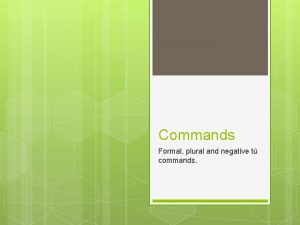Formal Commands Formal Commands In chapter 2 you























- Slides: 23

Formal Commands

Formal Commands • In chapter 2, you learned that command forms are used to tell someone what to do. • Formal commands are used with people you address as usted or ustedes. • For example: All of you


Usted and Ustedes • The usted and ustedes commands, like the negative tú commands, are formed by dropping the final -o of the yo form of the present tense. • For -ar verbs, add -e or -en. • For -er and -ir verbs, add -a or -an. Ex. caminar → yo camino → Ud. camine / Uds. caminen Ex. correr → yo corro → Ud. corra / Uds. corran Ex. escribir → yo escribo → Ud. escriba / Uds. escriban

Mamá, ¡por favor ayúdeme!

Niños, ¡limpien toda la casa!

Irregular Verbs • Verbs with irregular yo forms maintain the same irregularity in their formal commands. These verbs include conducir, conocer, decir, hacer, ofrecer, oír, poner, salir, tener, traducir, traer, venir, and ver.

¡Pongan atención!

Stem-changing verbs • Stem-changing verbs maintain their stem changes in the usted and ustedes commands.

CAR / GAR / ZAR • Verbs ending in -car, -gar, and -zar have a spelling change in the command forms.

Irregular Formal Commands

Negative Commands • To make a formal command negative, simply place no before the verb.

Reflexive / IOP’s / DOP’s • In affirmative commands, reflexive, indirect and direct object pronouns are always attached to the end of the verb.

Accent Marks • ¡Atención! When a pronoun is attached to an affirmative command that has two or more syllables, an accent mark is added to maintain the original stress.

Pronouns • In negative commands, these pronouns always precede the verb.

Formal • Usted and ustedes can be used with the command forms to strike a more formal tone. In such instances they follow the command form.

¡Vamos a practicar! Indica los mandatos (commands) afirmativos y negativos correspondientes. 1. escucharlo (Uds. ) 2. decírmelo (Uds. ) Escúchenlo _______. Díganmelo _______. 3. salir (Ud. ) Salga _______. 4. servírnoslo (Uds. ) Sírvannoslo _______. 5. barrerla (Ud. ) Bárrala _______. 6. hacerlo (Ud. ) Hágalo _______. No lo escuchen _____________. No me lo digan No salga _____________. No nos lo sirvan No la barra _______. No lo haga _______.

Translate the following using the Usted form of the command. 1. Wash the floor and clean the house. Lave el suelo y limpie la casa. 2. Don’t put the lamp on top of the end table. No ponga la lámpara encima de la mesita. 3. Straighten up the kitchen. Arregle la cocina. 4. Dust the furniture tomorrow. Sacuda los muebles mañana. 5. Close it (the closet). Ciérrelo. 6. Don’t dirty the carpet. No ensucie la alfombra.

Translate the following using the Ustedes form of the command. 1. Set the table tonight. Pongan la mesa esta noche. 2. Don’t iron the curtains. No planchen las cortinas. 3. Vacuum the dining room and the entrance. Pasen la aspiradora en el comedor y en la entrada. 4. Rent the house on our street. Alquilen la casa en nuestra calle. 5. Don’t move near the suburbs. No se muden cerca de las afueras. 6. Don’t beg! ¡No rueguen!

Fill in the blanks with the correct word from the word bank. dígales dé límpienlo sacúdala bórrenlos estén sepan lo haga bárranlos sírvanse sáquenla sea almuercen

sea 1. Sr. Ortega, no ______ tan malo con sus amigos. Usted hable con ellos y ________ que no dígales querías ofenderlos. sírvanse la comida a 2. Miguelito y Danielito, ________ las siete de la noche. Los suelos están demasiado bárranlos sucios. Por favor, ________. También hay mucha basura. Entonces, ________ sáquenla antes de que yo llegue del trabajo. Muchas gracias y ________ que los amo con todo mi corazón. sepan

3. Señoras y Señores, Hay un desastre en el límpienlo ahora! y luego comedor. ¡______ almuercen _______ el pollo que les preparamos. 4. ¡Mi mesita! ¿Por qué tiene tanto polvo? Don sacúdala Fernando, _______ por favor. Nuestros amigos van a llegar pronto. Quiero que ellos estén _______impresionados con nuestra casa.

dé 5. Guillermo, ____ su nuevo número al cliente pero no _______ hoy. Espere lo haga hasta el lunes. 6. Estudiantes, ¡Que terrible se ven todos estos problemas de matemáticas en la pizarra! bórrenlos por favor. ______
 What is internal commands
What is internal commands Formal and informal spanish commands
Formal and informal spanish commands Informal vs formal commands spanish
Informal vs formal commands spanish Irregular mandatos formales
Irregular mandatos formales Mandatos informales irregulares
Mandatos informales irregulares Mandatos formales spanish
Mandatos formales spanish Negative commands spanish
Negative commands spanish Informal commands spanish
Informal commands spanish Mandatos in english
Mandatos in english Mandatos formales
Mandatos formales Levantarse informal tu command
Levantarse informal tu command Solemn promises
Solemn promises How do you form ud and uds commands
How do you form ud and uds commands Do you love rain
Do you love rain You are what you eat do you agree or disagree
You are what you eat do you agree or disagree If you think you can you can poem
If you think you can you can poem Tell me what you eat and i shall tell you what you are
Tell me what you eat and i shall tell you what you are Lord i will follow you wherever you go
Lord i will follow you wherever you go Ejemplos de inculto formal
Ejemplos de inculto formal Formal education definition
Formal education definition Unit 3 formal informal and nonformal education
Unit 3 formal informal and nonformal education Kurikulum tersirat
Kurikulum tersirat Contoh kerangka karangan formal
Contoh kerangka karangan formal Is als a non formal education
Is als a non formal education
